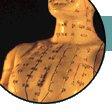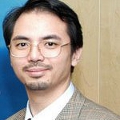The Five Elements Theory
The Five Elements theory posits wood, fire, earth, metal, and water
as the basic elements of the material world. These elements are in
constant movement and change. Moreover, the complex connections
between material objects are explained through the relationship of
interdependence and mutual restraint that governs the five elements.
In traditional Chinese medicine Five Elements theory is used to interpret
the relationship between the physiology and pathology of the human
body and the natural environment.
The Basic Content of the Five Elements Theory
The Categorization of Things
The ancient physicians used the Five Elements theory to study
extensively the connections between the physiology and pathology of
the zang-fu organs and tissues and the natural environment. By
adopting the methodology of "comparing similarity to expose phenomenon,"
the ancient Chinese attributed different phenomena to the categories
of the five elements. On the basis of the phenomena's different
characteristics, functions, and forms, the complex links between
physiology and pathology as well as the correlation between the human
body and the natural environment were explained.
Categorization of Zang, Fu, Flavours and Senses according to the Five Elements
|
Elements |
| Wood |
Fire |
Earth |
Metal |
Water |
| Flavors |
sour |
bitter |
sweet |
pungent |
salty |
| Zang |
liver |
heart |
spleen |
lung |
kidney |
| Fu |
gall bladder |
s. intestine |
stomach |
l. intestine |
urinary |
| Senses |
eye |
tongue |
mouth |
nose |
ear |
| Tissue |
tendon |
vessel |
muscle |
hair/skin |
bone |
Five Elements theory assigns each of the five elements a series
of abstract generalizations and then applies them to the classification
of all phenomena. Wood, for example, involved the aspects of germination,
extension, softness, and harmony. It is then inferred that anything
with those characteristics should be included in the category of the
wood element. As for the rest of the five elements: fire involves
the aspects of heat and flaring; earth involves the aspects of growing,
nourishing, and changing; metal is associated with cleaning up,
killing, strength, and firmness; and water is associated with
cold, moisture, and downward flowing. As in the case of wood, the
aspects of the other five elements are used to categorize all material
objects in terms of one of the particular five elements. The following
table shows the five categories of objects and phenomena according to
five elements classification.
Categorization of Objects, Nature and Phenomena according to the Five Elements
|
Elements |
| Wood |
Fire |
Earth |
Metal |
Water |
| Directions |
east |
south |
center |
west |
north |
| Changes |
germinate |
grow |
transform |
reap |
store |
| Color |
green |
red |
yellow |
white |
black |
The Mutual Generation, Mutual Subjugation, Extreme Subjugation,
and Counter Subjugation Relationships of the Five Elements
The Five Elements theory asserts that between each of the elements
there exists the close relationships of mutual generation, mutual
subjugation, extreme subjugation, and counter subjugation. The theory
explains the interrelatedness of all things through the use of those
close relationships.
Mutual generation means multiplication and promotion, while mutual
subjugation means mutual restriction and restraint. The order of mutual
generation among the five elements is that wood generates fire, fire
generates earth, earth generates metal, metal generates water, and
water generates wood. In this way generation is circular and endless.
In the mutual generating relation of the five elements, each of the
elements has the property of "being generate" and "generating." The one
which generates is the "mother," the one which is generated is the "son."
This is known as the "mother-son relationship." Each of the five
elements has this type of mutual generating relationship with the other.
According to the order of mutual subjugation, however, wood
subjugates earth, metal subjugates wood, etc. Each of the five
elements also shares this subjugation relationship with the other.
This relationship has the properties of "being subjugated" and of
"subjugating." The former means that my ability is inferior to the
object, while the later denotes my superiority to the object.
Therefore, the mutual subjugating relationship among the five
elements is also known as the relationship of "being superior
to" and "being inferior to" another element.
Mutual generation and mutual subjugation are two aspects
which cannot be separated. If there is no generation, then there
is no birth and growth. If there is no subjugation, then there
is no change and development for maintaining normal harmonious
relations. As the Leijing tuyi says, "If there is no generation,
then there is no growth and development. If there is no restriction,
then endless growth and development will become harmful."
Thus the movement and change of all things exists through
their mutual generating and subjugating relationships. These
relationships are the basis of the never ending circulation
of natural elements.
Extreme subjugation and counter subjugation are the
pathological conditions of the normal mutual generation
and subjugation relationships. Extreme subjugation denotes
that the subjugation of one of the five elements to another
surpasses the normal level. For example, if there is hyperactivity
of the wood element, it will subjugate the earth element.
The latter elements is made weak and insufficient.
Counter subjugation means that one of the five elements
subjugates the other opposite to the normal mutual subjugation
order. For example, when metal is weak and insufficient, it
leads to the hyperactivity of wood. The latter will then counter
subjugate the former. In the Suwen it says:
When the qi of one of the five elements is excessive,
it will subjugate its subjugated element (such as wood
subjugating earth) and counter subjugate the subjugating
element (such as wood counter subjugating metal).
Moreover, the Five Elements theory recognizes a correlation
between those things which are related to a particular element.
As the Suwen points out, "The East generates wind, wind
generates wood, wood generates sour, sour generates liver,
liver generates tendons....". According to Five Elements theory,
each element has its own repertory of relationships among the
objects that compose the physical world. The theory of Five
Elements is therefore the theoretical basis of the unique bond
between man and nature.
Related Subjects
Application of the Five Elements Theory to Traditional Chinese Medicine
| 
 This website is published, edited and designed by Raymond Cheng,
and reflects only and only his personal views and opinions in his individual capacity.
The information available at this website is not intended
directly or by implication to either diagnose or treat any
medical, emotional, or psychological condition or disorder.
It is also not intended to create a physician-patient relationship
between you and I or between you and Wyith Institute™ and The Office of Dr Raymond K K Cheng.
The information here is not a substitute for advice and treatment provided
by your physician or by another healthcare professional.
It is always recommended that consultation with local healthcare providers
be obtained for any of your specific health or medical concerns.
Furthermore, any products that can be purchased (yet you can see I don't have much
to sell here) through advertisers' banners or through links to other websites
are not either explicitly or implicitly given any warranty or endorsement
by me, my colleagues, Wyith Institute™ or any of its associated businesses.
This website is published, edited and designed by Raymond Cheng,
and reflects only and only his personal views and opinions in his individual capacity.
The information available at this website is not intended
directly or by implication to either diagnose or treat any
medical, emotional, or psychological condition or disorder.
It is also not intended to create a physician-patient relationship
between you and I or between you and Wyith Institute™ and The Office of Dr Raymond K K Cheng.
The information here is not a substitute for advice and treatment provided
by your physician or by another healthcare professional.
It is always recommended that consultation with local healthcare providers
be obtained for any of your specific health or medical concerns.
Furthermore, any products that can be purchased (yet you can see I don't have much
to sell here) through advertisers' banners or through links to other websites
are not either explicitly or implicitly given any warranty or endorsement
by me, my colleagues, Wyith Institute™ or any of its associated businesses.



 Thank you for visiting this TCM and acupuncture information website.
If you have previously been to this website, you might have
noticed that some of the pages on ancient historical ideas and
holistic thinkings related to Chinese metaphysics are temporarily taken offline.
This is because I will be revamping the whole website and be moving
those information into a new \"Ancient Chinese Culture\" section
so as to reflect a more current perspective on the interpretation
of some of the fundamental concepts as well as to include
some of the latest information in the area.
But if you have just found this website for the very first time, I welcome you again and
wish you could find what you require and, hopefully, you could also be benefitted
from reading the articles I published on this website.
Thank you for visiting this TCM and acupuncture information website.
If you have previously been to this website, you might have
noticed that some of the pages on ancient historical ideas and
holistic thinkings related to Chinese metaphysics are temporarily taken offline.
This is because I will be revamping the whole website and be moving
those information into a new \"Ancient Chinese Culture\" section
so as to reflect a more current perspective on the interpretation
of some of the fundamental concepts as well as to include
some of the latest information in the area.
But if you have just found this website for the very first time, I welcome you again and
wish you could find what you require and, hopefully, you could also be benefitted
from reading the articles I published on this website.